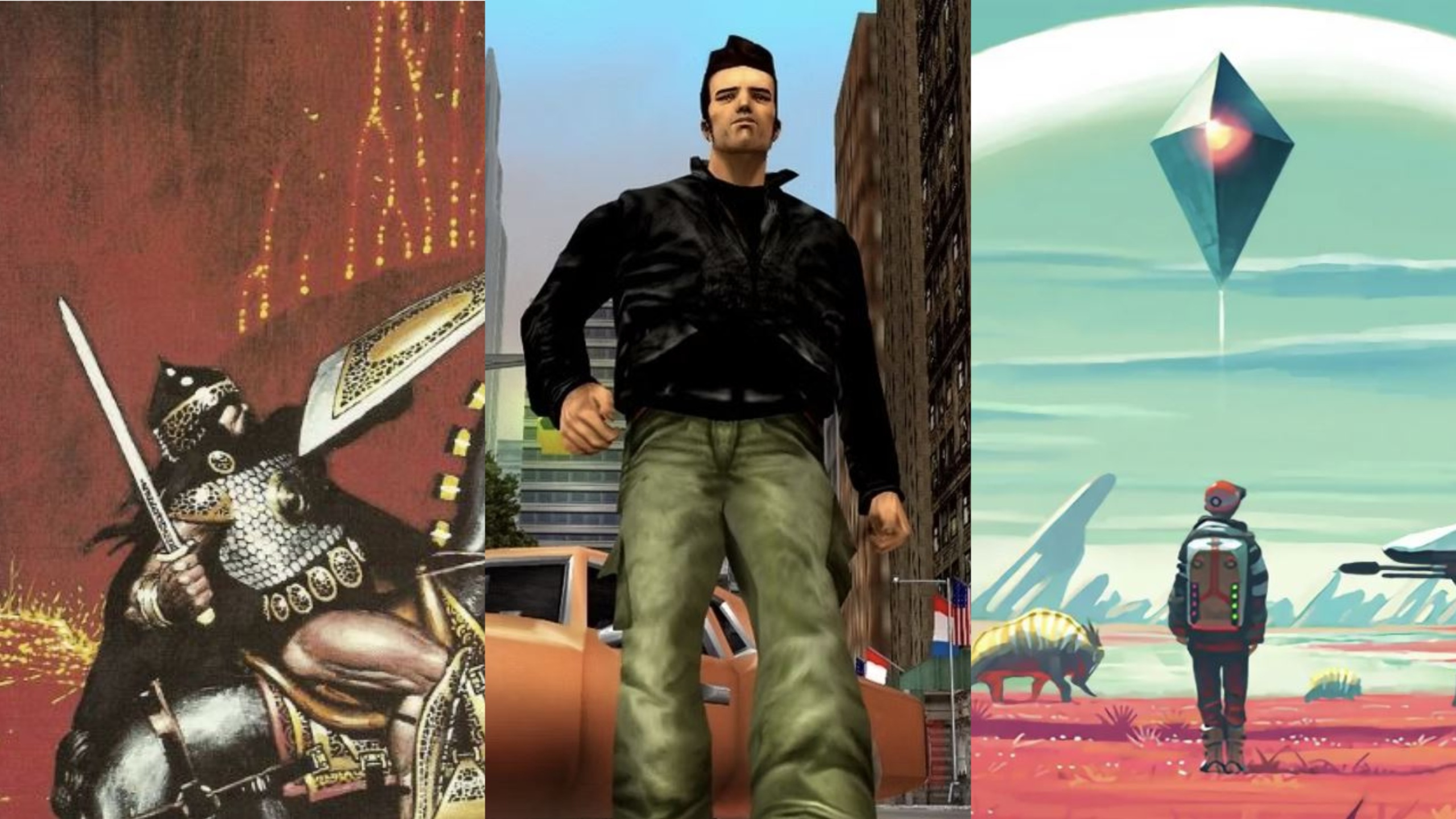
Gaming is fun for many reasons, but one of the big parts of it is the easy freedom. As long as the programming is good and the creativity is there, there is virtually nothing you can’t do, and all you need are your fingers, eyes, and a working brain. As time went on and technology advanced, so did the idea of freedom in a virtual world. Yes, I can go rescue the princess, but what if I don’t want to? What if I just want to converse with a rando or go fishing?
Open-world games became realized throughout the years and have become a staple of AAA releases. It’s redefined what an epic virtual experience really can be. Sometimes reaching out too far can be to the developers’ detriment, but when those games hit, they hit hard. Here’s a look at the games throughout the years that truly define the genre. Don’t confuse that with a list of the best of the genre. We have a list of that over here.
The thing is, defining open-world gaming is like playing one of those games. It’s hard to really pin down the right direction. It’s hazy, so looking at the true building blocks can be a bit of a challenge at times. To simplify things a bit, this list is going to use the old reliable “one game per franchise” rule.
Ultima I: The First Age of Darkness (1981)
There are arguments about what constitutes the first open-world game. To be completely honest, the splitting of hairs isn’t all that interesting. But then there’s Ultima, which is really the first open-world game that feels impactful and important. While incredibly rudimentary and dated, there is so much about this game that feels impressive for when it came out. The RPG elements, character creation, and exploration make the whole thing feel like such a revelation.
Granted, the game itself does go off the beaten path maybe a bit too much, considering after all this swords of sorcery stuff, it rather abruptly turns into a sci-fi space shooter. Listen, sometimes you just have to throw everything at the wall, because people are only going to care about what sticks. When you see this base game in action, you can’t help but watch the skeleton of the likes of Final Fantasy or Dragon Quest. These RPGs and their ilk truly embraced the open-world environment and there would be so many to talk about, but they absolutely owe their continued existence to this early release. – Gavin Jasper
Elite (1984)
Much like Ultima, this is one of those old games that is so ahead of its time that you must wonder if a deal with Satan was involved. Instead of open-world, Elite is practically open-universe as it allows you to fly through various galaxies and visit countless planets. The basic idea has you cruising through space and trying to build up your status and space wallet through various means, some more uncouth and violent than others.
Unlike Ultima, Elite was open-ended, which added to the experience. Outside of building up your rank into Elite, there’s little in terms of endings or streamlined narrative. You just go shoot up invaders, collect bounties, and barter over fuel and whatever. So many games and even genres owe a lot to this classic. – GJ
Mercenary (1985)
Mercenary had the novel concept of, “What if a flight simulator was interrupted by an alien civil war?” The idea is that you crash your ship onto the planet Targ, and you really want to get off the planet and go back to your non-Targ business. Your AI companion Benson explains that you can use more than half of your available funds to buy a ship, but the thing is, you don’t HAVE to buy it. You can steal it. It’s just that doing so will have dire consequences. Not dire in the sense that you will be killed (you can’t really die in the game), but you will be making some powerful enemies and might get shot out of the sky.
And that’s what this early sandbox game is all about. You accumulate wealth and try to earn an escape from this planet, all via playing a mercenary for either side of the war. Maybe both sides! The vector graphics here were really cutting edge in 1985, though Benson is needed to give everything context, considering how otherwise basic and non-descript everything is. Still, having a 3D journey in a virtual world and going in any direction you want was a big deal. – GJ
Legend of Zelda (1986)
“It’s dangerous to go alone. Take this.” That’s all you were told and from there came a legend. The gold-carted game is iconic, but it would not be nearly as memorable without its lack of direction. Legend of Zelda is a game based around traveling to various dungeons and finding the triangular treasures within but the whole thing revolves around exploration. Back in the days when Nintendo Power could reveal maps of those early NES games, few were as breathtaking as the fold-out poster that showed you just how expansive and wild Hyrule truly was.
There would be many nonlinear games on NES and SNES, but this is the one that truly put it on the map. It’s a game so nonlinear that people have been able to get all the way to Ganon without even picking up a single sword. Now, granted, that means that Ganon can’t be killed because you need that Master Sword to seal the deal, but that’s such an impressive feat that shows the versatility of the game design. – GJ
Sid Meier’s Pirates (1987)
Go sail around the chunks of the globe and gain great wealth and fame. That’s the basic idea of Sid Meier’s Pirates, but there’s so much more to it. So much so that seeing it in NES form was always so off-putting for younger me, because what’s with all the text? I wanted more swashbuckling and cannon fire! What we got was a ground-breaking adventurer simulator that was a little dry for something that took place on the seas but had so much going for it.
After choosing your era and nationality, it’s up to you to decide whether you want to fight pirates, avoid pirates, or even be a pirate, as you make your decisions and go on your aquatic journeys. Your choices help mold your fate as you spend years trading cargo, forging relationships, going on quests, and sword fighting. There is no true goal in there, but as time forces you into retirement, your success will be measured in what kind of life and legacy you are left with. – GJ
Hunter (1991)
In 1991, Activision released a 3D game that allowed players to navigate a relatively open world through various means, complete a variety of missions as they saw fit, and even enter buildings and interact with other characters. While Hunter builds upon some of those concepts we saw in Mercenary, it’s shocking to look back at this game and realize all of the things it was doing a decade before we had the words to properly describe some of those concepts.
Granted, many technical sacrifices had to be made to get those ideas to technically function in 1991. As such, it’s difficult (if not impossible) to play this one today and get much out of it due to how close it comes to replicating a more modern title without actually being able to get there. Still, you have to give love to a game that feels like the product of a time-traveling group of modern developers doing their best to make a 2005 title in 1991. – Matthew Byrd
Super Mario 64 (1996)
Granted, there isn’t much of a Super Mario “world” to Super Mario 64, but its freedom of movement and exploration is important to what would follow. Peach’s castle acts as a hub for the various adventures and actual levels, and the star system adds a lot of flexibility in how you go about the game. There’s a real novelty in checking out every nook and cranny of the castle, as well as its surrounding area. Maybe it’s too bold to call this game open-world, but it at least feels like a cousin at worst. If anything, the 3D environments and freedom to so easily peruse them feel like important inspirations for much of what would come next.
While Super Mario 64 would become the basis for the other 3D Mario platformers, it also walked so that Legend of Zelda: Ocarina of Time could run. Link’s 64-bit adventure felt like a cocktail of Super Mario 64 and what previous Zelda games had built. Its sequel, Majora’s Mask, went even further, and all that snowballed into the current 3D Zelda epics. Mario’s star-collecting and painting-jumping exploits definitely got the ball rolling. – GJ
The Elder Scrolls II: Daggerfall (1996)
The first Elder Scrolls game, Arena, was a very ambitious first-person action RPG that was held back by the available technology. Daggerfall built on what made Arena work and forged forward with a mind-blowing length of area to explore. No longer were you wandering towards endless fog and darkness. Now you can see villages filled with life and identity. The scale of the game is vast, and that includes the options as you take part in the game’s story.
You can join various guilds and organizations that could affect how NPCs perceive you. You can also play around with different magic types and even turn yourself into a supernatural being. With that and the various ways the game’s story could end, there’s a real feeling that Daggerfall is a major step in what the open-world genre would become over the years. – GJ
Shenmue (1999)
A year prior, the PlayStation 1 released Mizzurna Falls, a Twin Peaks-like mystery game that had some brilliant ideas in terms of town exploration, NPC behavior, and the movement of time. Sadly, the game was never released outside of Japan, causing it to become a cult favorite (only recently have modders successfully translated it to English). Shenmue for the Sega Dreamcast took the ideas present in Mizzurna Falls and created something more earth-shattering and complete, sadly to Sega’s own detriment.
Not only was Shenmue open-world, but it was so detailed and gave the player tons to do. Characters were more than static models to talk to but walked around with programmed daily routines. Night and day dictated the options of what you were capable of at any time. Sure, you could investigate your father’s murder and get into fights, but you could also just hang out with a stray cat or play at the arcade. Yes, playing a video game so your character could play video games. We are truly through the looking glass, people. – GJ
Grand Theft Auto III (2001)
The first two Grand Theft Auto games definitely had moxie as crime-based open-world games where you go around stealing cars and causing havoc. It’s just that the bird’s eye view held it back from meeting its true potential. Meanwhile, Eidos’ Urban Chaos came out on the PS1 in 1999, showing us a violent 3D sandbox of a game that really needed more time in the oven and better hardware. Grand Theft Auto III merged those games into a final form, creating something that completely changed the industry.
Yes, there was a plot, and with it came some shockingly high-profile voice actors (including orange juice spokesman Robert Loggia), but that was only window dressing for an immersive world where you could just do all the crime you wanted until the escalating law caught up with you. Then you’d die, dust yourself off, and go back to being just the worst person. Sequels, clones, and other games would ape on this release for years to come. – GJ
Spider-Man 2 (2004)
The video game adaptation for the first Sam Raimi Spider-Man movie was a solid affair, being one of those movie games that succeeded in padding out the narrative to make up for the fact that the source material only has so much action to copy. When your webbed hero only deals with a freaked-out dude with a gun, a few random muggers, and a supervillain with no henchmen to speak of, you really do need to throw in subplots about the Shocker and Vulture for flavor. The game was a linear exercise, but they went all out for the sequel, which turned into a full-on superhero simulator.
Granted, the sequel is missing the sweet, sweet Green Goblin vs. Green Goblin dogfighting boss fight from the first game but everything else is an improvement. The important thing here is that you can actually go do friendly neighborhood Spider-Man stuff when you don’t feel like forwarding the plot and punching Doc Ock in his stupid face. The map is made to match up perfectly with New York City, allowing you to swing around, deliver pizzas, save people from bad guys, and…uh…find balloons. It was a game that wasn’t about just saving the day, but about being a superhero and thriving in an environment that needed your help. Games like Arkham City and Infamous would follow in its footsteps, as would future Spider-Man titles.
The Insomniac Spider-Man games would especially take that groundwork and make something far more refined and better out of it. Miles better, you might say. – GJ
Just Cause (2006)
The first Just Cause is the weakest of the series and is very rough around the edges, but it builds on what Grand Theft Auto III created and goes further. Taking place in the fictional country of San Esperito, your reign of government-endorsed terror not only involves killing scores of armed enemies but also the environments themselves. In other words, while GTA3 was about playing around the landmarks, Just Cause was about playing through it.
This would be improved for the more beloved sequel, where you could not only commit acts of chaos but would be rewarded for it in-game by unlocking stuff. It’s derivative, but it really stands out by merging it with Pilotwings and an in-your-face action movie. – GJ
Assassin’s Creed (2007)
There was a lot of hype going into Assassin’s Creed’s release, and the game’s success exceeded expectations. Granted, the gameplay does get a bit repetitive and needs some work, but that’s what the countless sequels are for. Even then, the first game really feels like a breath of fresh air in terms of giving the video game world something new to sink their teeth into. While the ability to freely roam the cities did little to give you side distractions to keep your attention, the use of wandering the environment with such ease made this a huge deal. Climbing buildings and doing rooftop parkour as you prepare to take out your enemies made you feel like Batman (er, maybe Azrael) before they even had a full-on Batman version of this genre.
While this game would go on to give us a bunch of sequels and one of the most forgettable video game movies ever, it would also go down in history for giving us the Ubisoft Formula. Yes, outside of “we made Minions first, but they are rabbits,” the framework of Assassin’s Creed would become Ubisoft’s bread and butter throughout the years. Arguably to their folly in later times, but it’s still made them more money than God, so good on them. – GJ
S.T.A.L.K.E.R.: Shadow of Chernobyl (2007)
While S.T.A.L.K.E.R. isn’t quite as “open” as some of the other open-world games of this era, it makes up for its more zone-like structure with its emphasis on atmosphere and survival mechanics. While S.T.A.L.K.E.R. is filled with dangerous enemies, starvation, radiation, and dwindling resources are often your greatest threats in this first-person shooter that is often more intimidating than most horror games.
S.T.A.L.K.E.R. certainly wasn’t the first game to utilize such survival concepts, but its incorporation of those concepts into a more expansive open-world environment was fascinating. At a time when most developers saw such worlds as playgrounds, the S.T.A.L.K.E.R. team boldly suggested such worlds could be not just characters but antagonists. It almost certainly influenced upcoming titles like Far Cry 2 and Fallout 3, but arguably led to the more modern survival era of open-world games that includes everything from DayZ and Rust to Breath of the Wild and Death Stranding. – MB
Minecraft (2011)
Minecraft is the open world brought to its next logical point. A game that on the surface is about digging, exploring, gathering resources, and evading cube zombies is more about doing whatever the hell you want. Despite its simple-looking aesthetic, it’s taken the world by storm by becoming a hub for creativity, collaboration, and community. It’s not so much a game as it is an experience. Perhaps even its own artform.
It is the ultimate sandbox and an iconic use of imagination. The culmination of video game freedom. That said, Minecraft Steve’s spot in Super Smash Bros. Ultimate absolutely should have gone to Waluigi. Don’t you boo me! Wah! – GJ
No Man’s Sky (2016)
While the discussion around No Man’s Sky often revolves around the game’s notoriously disappointing debut and subsequent redemption (in the minds of some, at least), No Man’s Sky earns a spot in this discussion by virtue of its core design. No Man’s Sky creator Sean Murray desired to see how more modern technology could advance the procedural generation concepts that once made games like Elite possible. The promise of using such techniques to explore trillions of technically unique planets always seemed to be a bit too good to be true for some but was undeniably intriguing.
We’ve been wrestling with the results of that experiment in the years since No Man’s Sky’s release and will likely continue to do so for many years to come. More and more studios are arguing that similar procedural generation technology is the future of the genre even though the lack of genuine artistic identity in those trillions of worlds remains a constant criticism. As the subsequent growth of No Man’s Sky shows, though, perhaps there is a better world in which such techniques merely lay the foundation for bigger and better things to come. – MB
Red Dead Redemption 2 (2018)
The original Red Dead Redemption shocked many by offering so much more than “Grand Theft Horse.” The relative novelty of its open-world wild west setting was always appealing, but it was the game’s incredible narrative and shockingly entertaining exploration mechanics that elevated it. Deprived of the many amusements offered by a more modern GTA-like setting, the RDR team seemingly forced themselves to slow down and consider the weight of smaller moments such as merely wandering through the world.
Red Dead Redemption 2 took that idea to incredible new levels. While RDR and GTA 4 before it played with the idea of a slower, more mature kind of Rockstar title, RDR 2 was bold enough to intentionally slow the player down so that they could better appreciate the seemingly infinite number of little things that fill this game’s stunningly beautiful and robust world. With early reports suggesting that GTA 6 may be closer to RDR 2 than GTA 5, this could prove to be a turning point for developer Rockstar and therefore the open-world genre. – MB
The post The History and Evolution of Open-World Games appeared first on Den of Geek.










